
School:
Grade Level:
Teaching Position:
Supervisor:
Department:
Mentor:
Research Project Year:
Research Project Title:
Research Project Description:
Polyethylene glycol (PEG) is a nonimmunogenic hydrophilic polymer that can be use as a carrier media to decrease opsonization of drugs from the human body and increase blood circulation time. To exploit the properties of PEG, drugs may be PEGylated by reaction of a drug molecule with carefully selected reactive end-groups on PEG. However, PEGylation is typically limited to one drug molecule per PEG. We are working on a novel approach that will enable attachment of many functional groups along the backbone of PEG by copolymerization of ethylene oxide with propargyl glycidyl ether. We synthesized propargyl glycidyl ether in high yield and purity, and carried out polymerization by both activated-monomer, and oxyanionic polymerization. The activated-monomer resulted in no polymer formation. However, oxyanionic polymerization resulted in the formation of polymer with a number-average molecular weight of 9 kDa, and a polydispersity of 2.3.
Research Project Attachments:
| Attachment | Size |
|---|---|
| 7.58 MB |
Curriculum Project Year:
Curriculum Project Title:
Curriculum Project Description:
This compact two week long high school chemistry curriculum provides basic lessons on polymers addressing CST standards as well as extension activities that focus on innovation and creativity. The three main themes of this project are introduction to polymers, applications of polymeric materials, and polymers for the environment. Hands-on explorations of polymer synthesis include experiments with polyvinyl alcohol (PVA) and acetone (“fibers”), PVA and borax (“slime”), mixtures of silicone and corn starch (“oogoo”), a novel material for the science classroom, and casein “bioplastic” obtained from combining vinegar and milk. Modeling of polymerization is explored via polycaprolactone thermoplastic (“hand moldable plastic”) and activities exploring various gadgets using oogoo and extension units on the degradation of casein, super-absorbant hydrogel and soft robotic devices are also introduced.
Curriculum Project Highlight:
Curriculum Project Attachments:
| Attachment | Size |
|---|---|
| 2.82 MB | |
| 49.54 KB | |
| 225.84 KB | |
| 226.11 KB | |
| 238.43 KB | |
| 181.8 KB | |
| 15.76 KB | |
| 46.9 KB | |
| 46.14 KB | |
| 1.44 MB | |
| 996.73 KB | |
| 46.78 KB |
